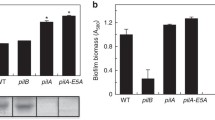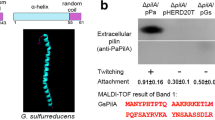Abstract
Pseudomonas aeruginosa is a metabolically voracious bacterium that is easily manipulated genetically. We have previously shown that the organism is also highly electrogenic in microbial fuel cells (MFCs). Polarization studies were performed in MFCs with wild-type strain PAO1 and three mutant strains (pilT, bdlA and pilT bdlA). The pilT mutant was hyperpiliated, while the bdlA mutant was suppressed in biofilm dispersion chemotaxis. The double pilT bdlA mutant was expected to have properties of both mutations. Polarization data indicate that the pilT mutant showed 5.0- and 3.2-fold increases in peak power compared to the wild type and the pilT bdlA mutant, respectively. The performance of the bdlA mutant was surprisingly the lowest, while the pilT bdlA electrogenic performance fell between the pilT mutant and wild-type bacteria. Measurements of biofilm thickness and bacterial viability showed equal viability among the different strains. The thickness of the bdlA mutant, however, was twice that of wild-type strain PAO1. This observation implicates the presence of dead or dormant bacteria in the bdlA mutant MFCs, which increases biofilm internal resistance as confirmed by electrochemical measurements.





Similar content being viewed by others
References
O’Toole GA (2003) To build a biofilm. J Bacteriol 185(9):2687–2689
Guo K, Hassett DJ, Gu T (2012) Microbial fuel cells: electricity generation from organic wastes by microbes. In: Advances in microbial fuel cells for potential energy production from organic feed streams. Chapter 12, in microbial biotechnology: energy and environment edited by R. Arora. CAB International, Oxon (ISBN 978-1845939564)
Yong XY et al (2014) Enhancement of bioelectricity generation by cofactor manipulation in microbial fuel cell. Biosens Bioelectron 56:19–25
Shen HB et al (2014) Enhanced bioelectricity generation by improving pyocyanin production and membrane permeability through sophorolipid addition in Pseudomonas aeruginosa-inoculated microbial fuel cells. Bioresour Technol 167:490–494
Shreeram DD, Hassett DJ, Schaefer DW (2016) Urine-powered microbial fuel cell using a hyperpiliated pilT mutant of Pseudomonas aeruginosa. J Ind Microbiol Biotechnol 43(1):103–107
Mukherjee S et al (2013) A microliter-scale microbial fuel cell array for bacterial electrogenic screening. Sens Actuators A Phys 201:532–537
Gao Y, Hassett DJ, Choi S (2017) Rapid characterization of bacterial electrogenicity using a single-sheet paper-based electrofluidic array. Front Bioeng Biotechnol 5:44
Rabaey K et al (2005) Microbial phenazine production enhances electron transfer in biofuel cells. Environ Sci Technol 39(9):3401–3408
Qiao YJ et al (2017) Biofilm promoted current generation of Pseudomonas aeruginosa microbial fuel cell via improving the interfacial redox reaction of phenazines. Bioelectrochemistry 17:34–39
O’Toole GA, Kolter R (1998) Flagellar and twitching motility are necessary for Pseudomonas aeruginosa biofilm development. Mol Microbiol 30:295–304
Hassett DJ et al (2010) Pseudomonas aeruginosa biofilm infections in cystic fibrosis: insights into pathogenic processes and treatment strategies. Expert Opin Ther Targets 14(2):117–130
Chiang P, Burrows LL (2003) Biofilm formation by hyperpiliated mutants of Pseudomonas aeruginosa. J Bacteriol 185(7):2374–2378
Zolfaghar I, Evans DJ, Fleiszig SM (2003) Twitching motility contributes to the role of pili in corneal infection caused by Pseudomonas aeruginosa. Infect Immun 71(9):5389–5393
Morgan R et al (2006) BdlA, a chemotaxis regulator essential for biofilm dispersion in Pseudomonas aeruginosa. J Bacteriol 188(21):7335–7343
Petrova OE, Sauer K (2012) Dispersion by Pseudomonas aeruginosa requires an unusual posttranslational modification of BdlA. Proc Natl Acad Sci USA 109(41):16690–16695
Choi G, Hassett DJ, Choi S (2015) A paper-based microbial fuel cell array for rapid and high-throughput screening of electricity-producing bacteria. Analyst 140(12):4277–4283
Holloway B (1955) Genetic recombination in Pseudomonas aeruginosa. J Gen Microbiol 13:572–581
Hoang TT et al (1998) A broad-host-range Flp-FRT recombination system for site-specific excision of chromosomally-located DNA sequences: application for isolation of unmarked Pseudomonas aeruginosa mutants. Gene 212(1):77–86
Mattick JS (2002) Type IV pili and twitching motility. Annu Rev Microbiol 56:289–314
Klausen M et al (2003) Biofilm formation by Pseudomonas aeruginosa wild type, flagella and type IV pili mutants. Mol Microbiol 48(6):1511–1524
Rahme LG et al (1995) Common virulence factors for bacterial pathogenicity in plants and animals. Science 268:1899–1902
Li K et al (2013) SuhB is a regulator of multiple virulence genes and essential for pathogenesis of Pseudomonas aeruginosa. MBio 4(6):e00419-13
Acknowledgements
This work was supported, in part, by the Procter and Gamble Company (Cincinnati, OH) to D.D.S. and National Science Foundation CBET Grant 1605787 to S.D. and D.J.H.
Author information
Authors and Affiliations
Corresponding author
Rights and permissions
About this article
Cite this article
Shreeram, D.D., Panmanee, W., McDaniel, C.T. et al. Effect of impaired twitching motility and biofilm dispersion on performance of Pseudomonas aeruginosa-powered microbial fuel cells. J Ind Microbiol Biotechnol 45, 103–109 (2018). https://doi.org/10.1007/s10295-017-1995-z
Received:
Accepted:
Published:
Issue Date:
DOI: https://doi.org/10.1007/s10295-017-1995-z




